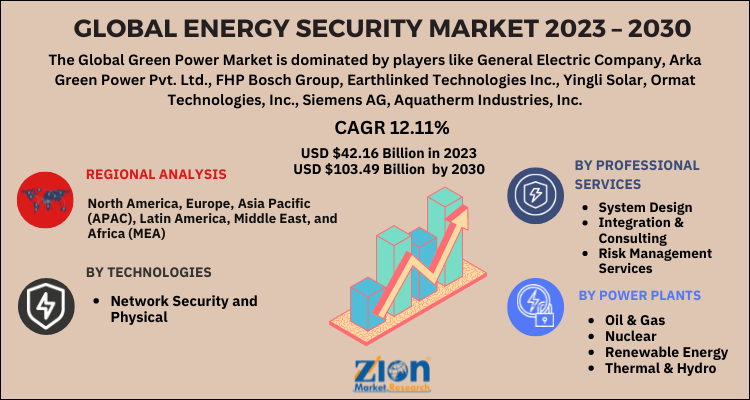The size of the worldwide energy security market was estimated to be around USD 15.43 billion in 2024 and is expected to increase at a compound annual growth rate (CAGR) of around 9.18% between 2024 and 2032 to be around USD 31.45 billion.
Introduction
Energy security has become a critical focus for nations and organizations globally, driven by geopolitical uncertainties, climate change, and technological advancements. The energy security market encompasses a range of strategies and technologies aimed at ensuring reliable, sustainable, and resilient energy systems. This article delves into the current trends, opportunities, and future prospects of the energy security market.
Market Overview
Energy security refers to the ability of an energy system to ensure a continuous supply of energy at affordable prices while minimizing risks associated with energy disruption. This market includes a variety of solutions, such as energy storage systems, cybersecurity measures, diversified energy sources, and infrastructure resilience strategies. As global energy demands grow and the energy landscape evolves, the importance of energy security continues to rise. The ability of the energy system to promptly respond to sudden changes in the supply-demand balance is the main focus of short-term energy security. Long-term security is mainly concerned with providing energy to meet environmental needs and economic developments with timely investments. Energy security is defined as the availability of energy sources in an uninterrupted manner at a reasonable cost. It depends on a dependable, economical, and adequate supply of energy that offers a degree of independence. There are chances of conflict with uneven distribution and inequitable availability of energy sources.
 Energy Security Market
Energy Security Market
Factors Driving the Global Energy Security Market
Some of the main factors driving the growth of the worldwide energy security market include the increasing need to safeguard energy supplies from physical and cyberattacks, the rise in demand for energy, and the accelerating use of energy security solutions. The majority of the nations lack a suitably unified energy market and are heavily dependent on energy supply from a single source. Furthermore, the world’s oil reserves are running out quickly, and climate change is happening quickly as well.
This in turn highlights the need to strengthen the drive behind the energy’s redirection from fossil fuels to a variety of energy resources, underscoring the need of energy security. Energy resources, particularly oil and gas, are a major cause of war and strife in many parts of the world, either directly or indirectly. The states are searching for a strategic alternative that is affordable and reliable enough to withstand the industrial infrastructure in response to the political turmoil and fierce competition for energy resources.
As a result, there is a growing need for energy security solutions, which supports the expansion of the global market. Additionally, the government’s significant investments in research and development to create new technologies, together with the growing use of nuclear energy as a source of energy, could present more potential prospects for the global energy security market during the course of the projected period. But the main thing impeding the expansion of the global energy security sector is the operators’ lack of awareness.
 Energy Security Market
Energy Security Market
The Covid-19 pandemic has had a devastating impact on economics, health systems, society, and has caused the greatest global disaster. The governments of several nations are concentrating primarily on controlling the disease’s spread and boosting their economy, with unprecedented dimensions. Global trade, transportation, and economic activity have all slowed down as a result of the severe lockdowns and limitations on commerce and transportation. The need for energy, particularly power and oil, decreased in the nations that were under total lockdown.
The first quarter of 2020 saw a complete lockdown on nations including the UK, Spain, Italy, and France, which reduced demand for electricity. In addition, the machinery and equipment delivery was also halted as a result of the supply chain interruption. Reduced investment in energy-related activities was also a result of the restrictions on the mobility of people and products. During the pandemic, the growth of the global energy security industry was significantly impacted by all of these reasons together.
Global Market for Energy Security: Report Extent
 Energy Security Market
Energy Security Market
Global Market for Energy Security: Segmentation
Power plants, regions, professional services, and technology are used to classify the worldwide energy security market. The network security and physical security segments of the global energy security market are divided based on technologies. The global market is divided into four segments based on professional services: managed services, system design, integration & consulting, risk management services, and integration. The oil and gas, nuclear, renewable energy, thermal, and hydro categories are used to categorise the power plant section.
Regional Analysis of the Global Market for Energy Security
During the projected period, North America is anticipated to dominate the worldwide energy security market. The market in this region is expanding due to factors like the use of cutting-edge technologies to protect energy resources from cyber- and physical-attacks, the presence of major players, the rise in demand for sophisticated networks, and the rise in spending on energy security solutions. Asia Pacific, on the other hand, is anticipated to increase quickly over the projected time. This can be linked to an increase in government measures aimed at ensuring security compliance.
Key Market Drivers
- Geopolitical Instabilities: Conflicts and political uncertainties in energy-rich regions drive the need for secure and diversified energy sources.
- Cybersecurity Threats: Increasing cyber threats to critical energy infrastructure highlight the need for advanced cybersecurity solutions.
- Climate Change and Sustainability: The transition to renewable energy sources and the push for climate resilience are shaping energy security strategies.
- Technological Advancements: Innovations in energy storage, grid management, and monitoring technologies are enhancing energy security capabilities.
Challenges
- Infrastructure Vulnerabilities: Aging infrastructure and vulnerabilities to natural disasters and cyberattacks pose significant risks to energy security.
- Regulatory and Policy Uncertainty: Fluctuating regulations and policies can impact investments and strategies related to energy security.
- Integration of Renewable Energy: Balancing renewable energy sources with grid reliability and stability remains a challenge for energy security.
Market Segmentation
The energy security market can be segmented based on solution type, application, and region.
- By Solution Type: Energy storage systems, cybersecurity solutions, diversified energy sources, smart grid technologies, infrastructure resilience.
- By Application: Government and defense, utilities, industrial sectors, commercial buildings, residential.
- By Region: North America, Europe, Asia-Pacific, Latin America, and the Middle East & Africa.
Regional Insights
- North America: Focuses on cybersecurity, grid modernization, and energy diversification due to its large and complex energy infrastructure.
- Europe: Emphasizes the integration of renewable energy sources and energy efficiency measures to enhance energy security.
- Asia-Pacific: Rapid industrialization and increasing energy demand drive investments in energy security technologies and infrastructure.
- Latin America and the Middle East & Africa: Emerging markets with growing energy needs and infrastructure development are investing in energy security solutions.
Key Players
Several companies are leading the energy security market with their advanced technologies and comprehensive solutions. Notable players include:
- Schneider Electric: Provides energy management and automation solutions to enhance energy security and efficiency.
- Siemens Energy: Offers a range of technologies and services for energy generation, transmission, and distribution security.
- General Electric (GE): Specializes in energy infrastructure solutions, including grid management and energy storage systems.
- Honeywell International: Provides cybersecurity solutions and smart grid technologies to protect energy infrastructure.
- ABB Ltd.: Focuses on digitalization and automation solutions to improve energy system resilience and security.
Future Prospects
The future of the energy security market is promising, with several factors driving growth:
- Technological Innovation: Continued advancements in energy storage, smart grid technologies, and cybersecurity will enhance energy security solutions.
- Investment in Infrastructure: Increased investments in modernizing energy infrastructure and improving resilience will support market growth.
- Global Climate Goals: The pursuit of climate goals and the transition to renewable energy sources will drive demand for energy security solutions.
- Emerging Threats: Growing concerns about cyberattacks and infrastructure vulnerabilities will lead to increased focus on protective technologies.
Conclusion
The energy security market is evolving rapidly in response to growing global energy demands, technological advancements, and geopolitical uncertainties. While challenges such as infrastructure vulnerabilities and regulatory uncertainty exist, ongoing innovations and investments in energy security technologies will continue to drive market growth. As nations and organizations prioritize reliable and resilient energy systems, the energy security sector will play a crucial role in ensuring a stable and sustainable energy future.
Contact Us:
Zion Market Research212
USA/Canada Toll Free: 1 (855) 465–4651
Newark: 1 (302) 444–016611\
Web: https://www.zionmarketresearch.com/
Blog: https://zmrblog.com/
Browse other trend reports:
